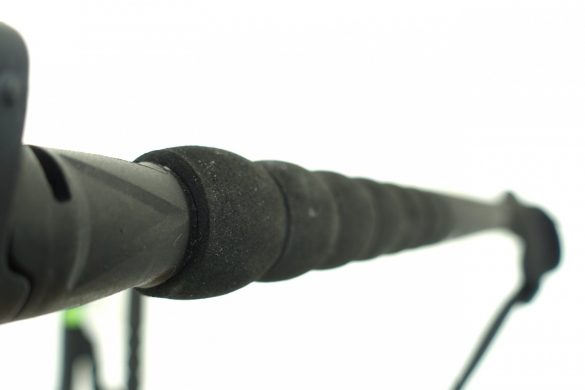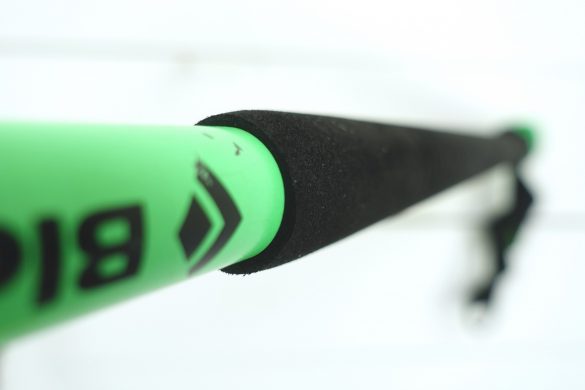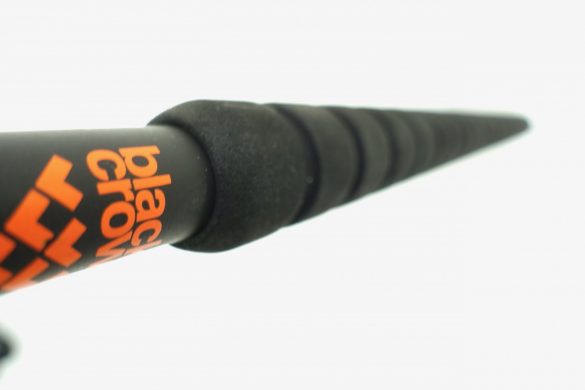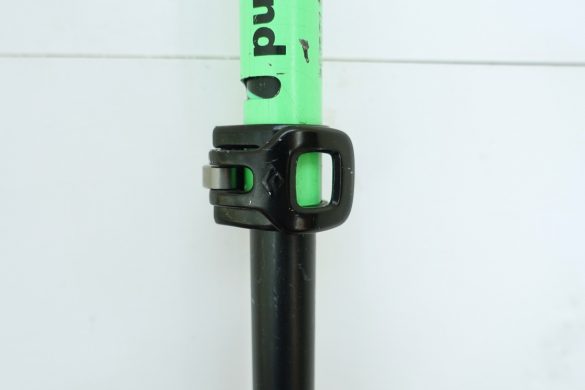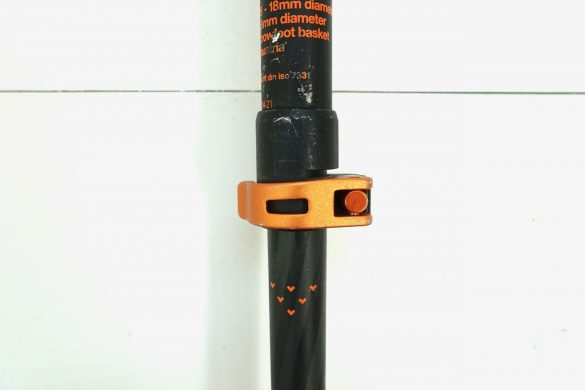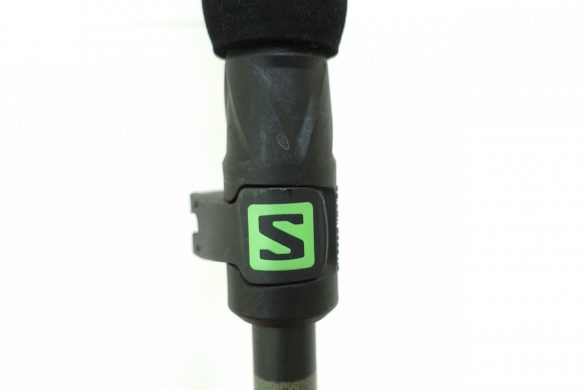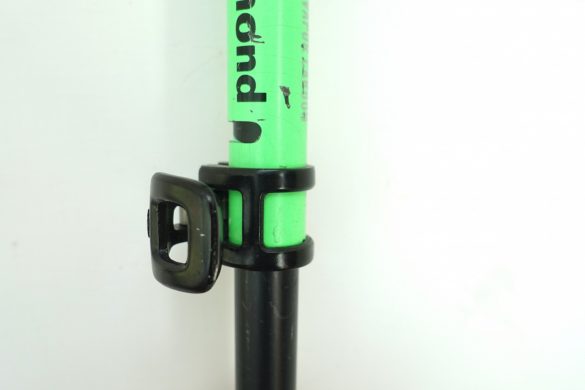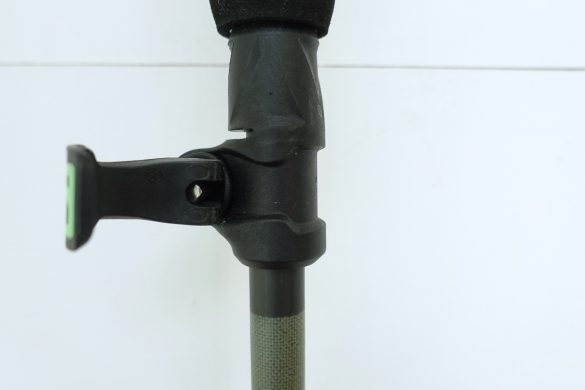While not exactly Thunderdome, three ski poles enter the WildSnow ring as we review poles featuring two-piece telescoping sections and extended grips. Here come the Black Crows Duos Freebird, the Black Diamond Vapor Carbon 2, and the updated Salomon MTN Carbon S3.
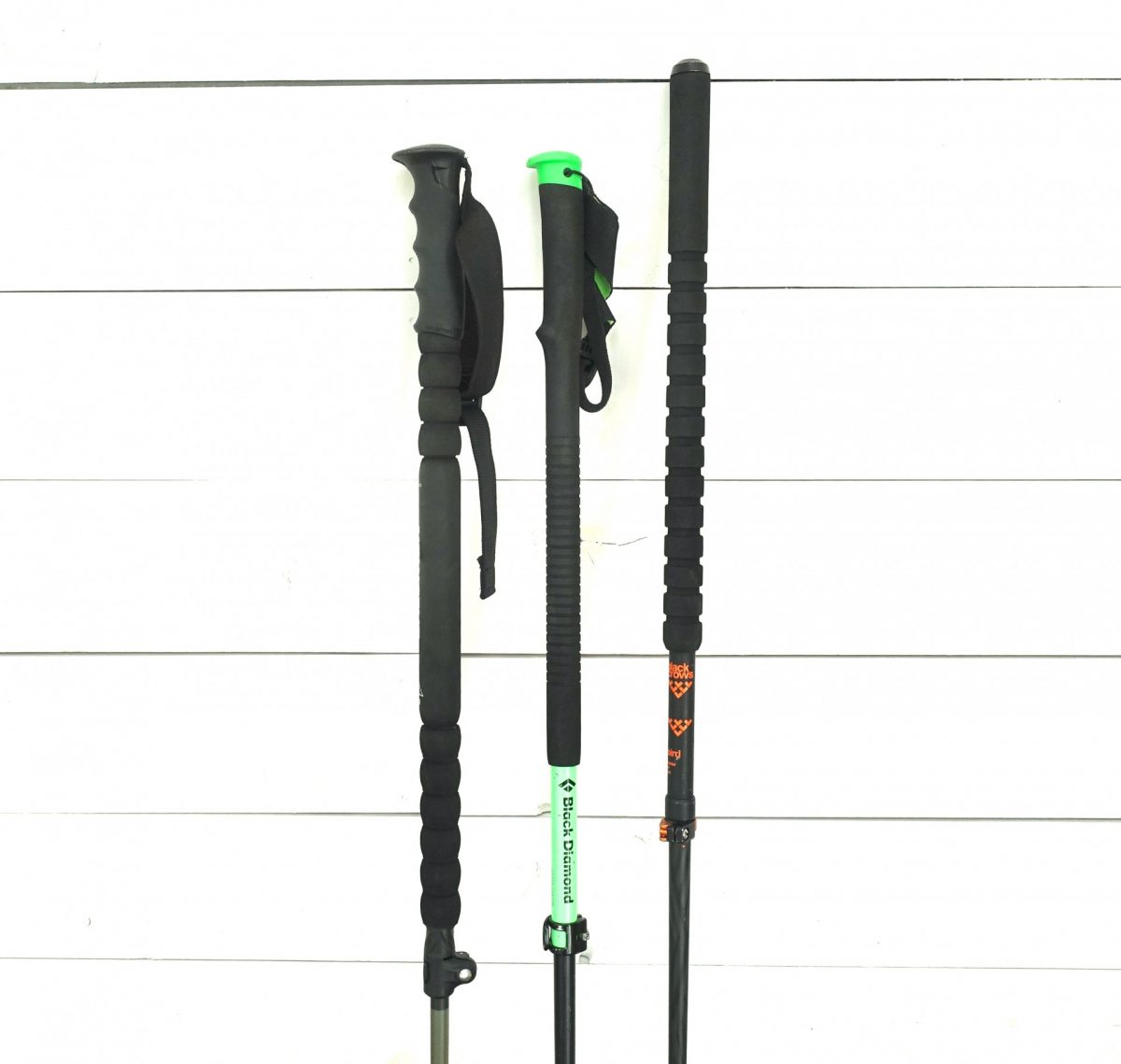
The elongated grips on full display with the shafts extended to their longest position. From left to right, 2022/2023 MTN S3, Vapor Carbon 2, and the Duos Freebird.
In our last pole review, the Folkrm Wyeast ( you can read our full review here), a baton style, fixed length doo-dad, we didn’t necessarily break comment records, but 45 comments say a lot. There were those with a proclivity for thrift who found ski poles at the gear swap— not a bad idea for those wanting a fixed-length and willing to extend the stock grip with bike handlebar tape just-so. Others found the nuances of ski pole design a delight. This review is for those delighting in engineers and designers using calipers, and foam, and carbon, and adjustability to fabricate a ski pole for those fixating on finding that perfect fulcrum point, swing weight, functionality, and possibly, as we are entering the realm of carbon poles, durability.
There’s three poles and three personalities to size up. Up for review are the Black Crows Duos Freebird, the Black Diamond Vapor Carbon 2, and the updated Salomon MTN Carbon S3, which struts into the ring as a reboot. Yeah, the same pole that received the Outside treatment and buzz on forums needing to know the deets of Cody Townsend’s prototype pole.
A ski pole is a ski pole, but not exactly. (Top to bottom: BD Vapor Carbon 2, Black Crows Duos Freebird, Salomon MTN S3.)
All three makes are two-piece, height adjustable telescopic units with each brand’s take on BD’s original venerable Flicklock system. And all three feature baton-style elongated foam grips. That’s about where the non-granular similarities end.
Well, hold on for three more sentences. All three extended grips offer more hand position options for ascending and descending. Shortening or lengthening the effective pole length on the fly (without adjusting the length telescopically), simply by moving your hand up or down the grip, is seamless and priceless for side-hilling or dialing in a preferred grip position that might change with slope angle when dancing down the steeps. And if it’s about dancing anyway, I’ve found adjustable baton-style poles help keep the beat.
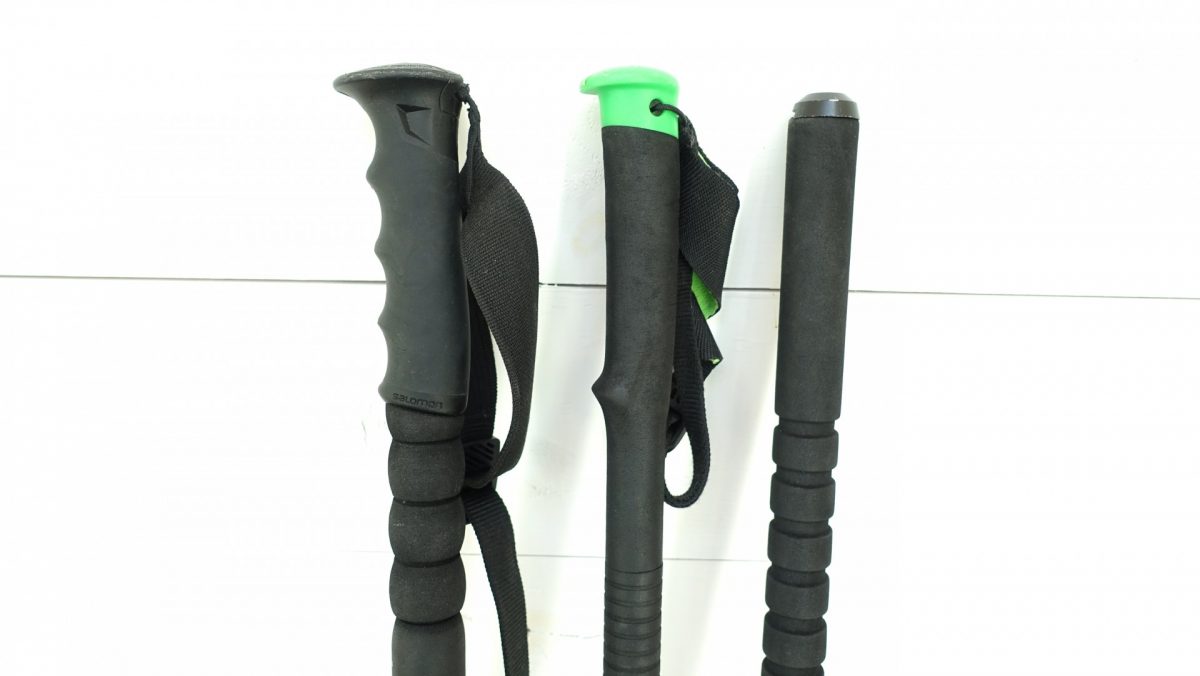
Three styles of hand grip. The MTN S3 (left) features a rubberized molded grip. The Vapor Carbon 2 (middle) sports a foam grip with a small lip below the pinky spot otherwise no finger molds. The Duos Freebird has a simple relatively untextured foam hand grip section.
The Ski Pole Specs
Let’s Talk Grips
For those with smaller hands like the former president, no shame in that; the Black Crows Duos Freebird and the BD Vapor Carbon 2 will suit you better if you prefer a smaller diameter grip. The Vapor Carbon 2’s main elongated grip sits between the calipers (diameter) at 24mm; the Duos Freebird’s main grip sits at 26mm between the caliper jaws.
The Salomon MTN S3’s main grip has three distinct sections (all below the hand grip). The middle opens the calipers to 30mm, whereas the upper and lower portions open the jaws to 28mm. This grip may feel more comfortable for the average to bigly-handed among us.
The Salomon MTN S3, the heaviest of these poles, has an extended-grip 40.5cm in length, which covers the entire upper pole section outside the hand grip. The hand grip (11.3cm in length) is rubberized and firm, molded with resting spots for each finger, and is oval. Although I could mention the MTN S3’s wrist straps in many places in this review, here’s a good spot. Their size is adjustable, and they remove quickly. A spring-loaded mechanism secures the strap in place; the spring tension is adjustable. Think of these as breakaway wrist straps if you are someone who wears straps while descending. The following has not been confirmed and is speculation, but from how well designed this breakaway unit is, I assume the straps would rip away in the event of a slide, not allowing the poles to drag you under. At 22g, the wrist straps are not super light. Yet, wrist strap removal is easy if you’d instead like to do without and stuff them in a pocket. This feature is nice (see below) for ski mountaineers who plunge poles grip first into the snow for a secure point of contact while ascending.
The Vapor Carbon 2’s extended grip runs 29cm. The handgrip, at 11.5cm, is firm and grippy and capped with plastic. There are no molded resting spots for your fingers, yet there is a small ridge (under where the pinky rests) to help prevent your hand from creeping/slipping down. Evidently, (see comments below, and this is an update), the straps are removable on the Vapor Carbon 2, although this is not evident from any documentation found at the time of the original publish date. Here’s what a reader found to remove the grips, “it requires a small screw driver (think eye glass repair kit size). BD customer support provided instructions upon request. Glad I asked BD before cutting my straps off. I’m not sure why the instructions are not available on the BD website.”
The Duos Freebird’s extended-grip section extends 26.7cm. The hand grip section adds 11.5cm of grip and is not molded for digits. The top is capped with a round machined aluminum piece, and the basic adjustable wrist straps are removable— but you’ll need to unfasten a screw atop the pole for removal.
One more time, here’s the length rundown for grips:
MTN Carbon S3: handgrip length — 11.3cm, extended-grip length — 40.5cm. Grip length total is 51.8cm.
Vapor Carbon 2: handgrip length – 11.5cm, extended-grip length — 29cm. Grip length total is 40.5cm.
Duos Freebird: handgrip length — 11.5cm, extended-grip length — 26.7cm. Grip length total is 38.2xm.
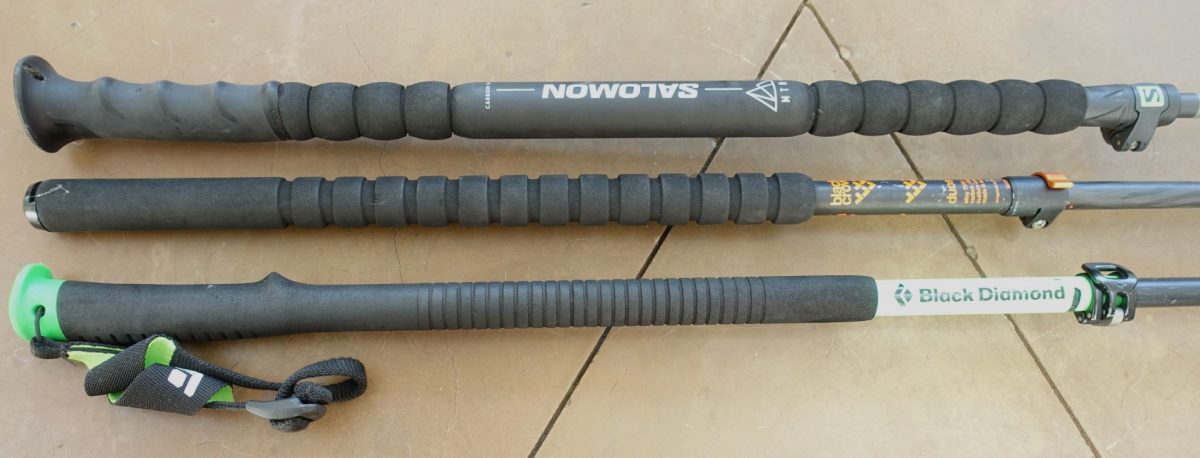
Three styles of elongated grips on display: MTN S3 (top), Duos Freebird (middle), and Vapor Carbon 2 (bottom).
Ski Pole Durability
Know this: I’ve not snapped a pole section yet with any of these poles. The likely culprit for a snap, though, is the lower section. With more delicate poles (yeah, carbon poles), I try to use a slightly lighter touch when polling or plunging in conditions that could either snag the basket or allow the pole to sink into the snowpack as I move forward. With the slightest resistance from the pole lower as I extend my arm to push, I release the grip, taking any undo twist or pressure off the lower shaft, hopefully avoiding a snapped section. Most often, this requires me to pole/skin without the wrist straps attached — it’s easier to release the pole without the wrist strap secured.
Have I witnessed carbon poles snap? You betcha. Bring a few Voile Straps or Titan Straps along and have a plan to fix a snapped section. I’ve seen someone splint a broken pole section with a thick twig and two straps.
The upper sections of these poles are less likely to break. Yet the Vapor Carbon 2’s upper, which I like, does feel the most delicate of the bunch. With the wrist strap, the Vapor Carbon 2’s upper is the lightest. Without wrist straps on the Duos Freebird, the Vapor Carbon 2 and Duos Freebird come in for a photo finish; they are nearly identical in weight. The upper section of the Duos Freebird is aluminum, whereas the Vapor Carbon 2 is all carbon. While inverting the poles on a booter, plunging grip first into the snow, the aluminum section causes me less stress because I sense I can plunge with gusto rather than being more delicate with the Vapor Carbon 2’s carbon.
The MTN S3, although featuring a carbon upper, feels more tank-like. With its greater mass and foam grip extending longer than on the Vapor Carbon 2, I feel like I can plunge the pole (grip first) with caution to the wind— these are burly units.
The green paint on the Vapor Carbon 2 can chip away; this seems only cosmetic. To my eyes, this chipping does not affect the carbon layup underneath. However, I brought the Vapor Carbon 2s on a six-day traverse and was glad to have them, paint chips aside.
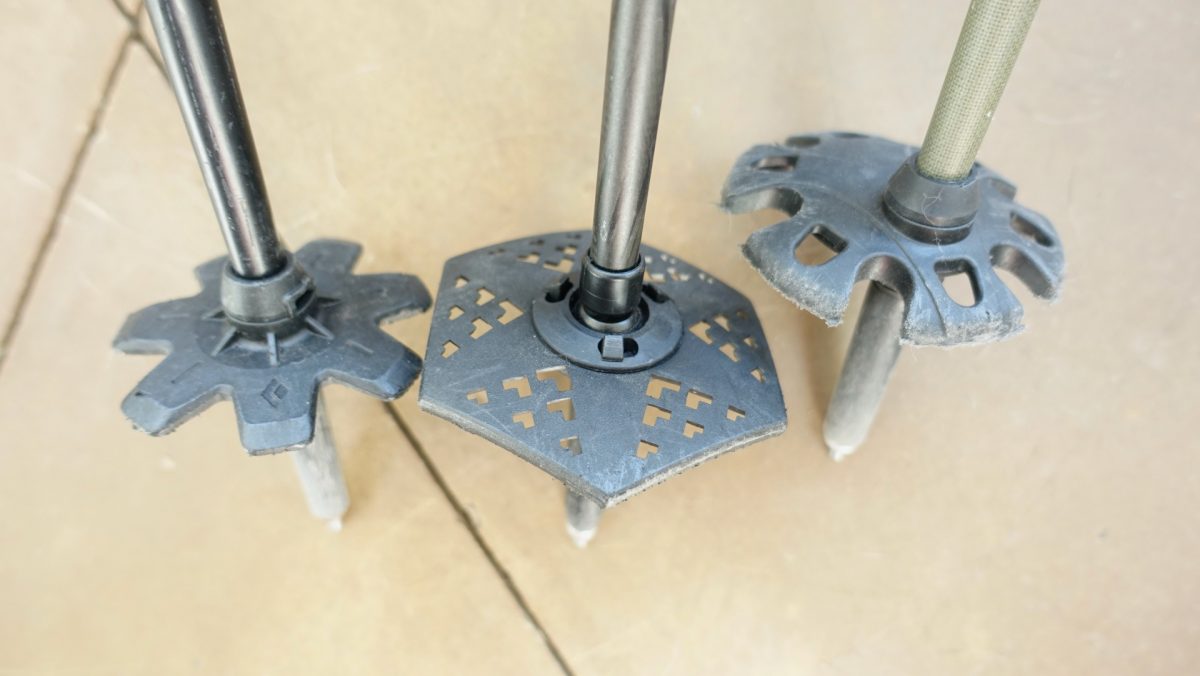
Baskets are baskets. The Vapor Carbon 2 baskets (left) has the smallest diameter. The Duos Freebird’s basket (middle) is the largest and articulates on a ball socket which feels nice and smooth when poling in firm snow. The MTN S3 basket (right) features a reduced radius on the pole’s front side, which in theory helps with the poling action on firm snow. The truth, all the baskets work great in deep and firm snow; they are all replaceable and removable.
Ski Pole Swing-weight
Swing-weight is one metric of the rarefied ski pole metrics, which is a personal preference. Some skiers like some heft behind the swing, while others prefer unobtainium lightness. My sweet spot length for telescoping poles is usually 125cm. I’m 5’10 in flip-flops, taller in ski boots, and locked into bindings. With all three poles adjusted to this length, the Vapor Carbon 2 feels the most feather-like. This makes sense: the basket is relatively minimal, both the upper and lower pole segments are carbon, and the foam grip has just about the right amount of foam; it’s not too thick.
Next comes the Duos Freebirds. Their swing weight is just a pebble or two heavier than the Vapor Carbon 2; noticeable, yes, but only slightly so. And this, too, makes sense, the pole upper is aluminum, and the grip’s foam is marginally thicker than the Vapor Carbon 2’s foam.
Then comes the “heavier” weight. If we can personify the poles, and the MTN S3 was shadow boxing, I’m guessing the Vapor Carbon 2 and Duos Freebird would be quaking. Overall, the MTN is simply a more robust pole. (More on this in the conclusion). As mentioned, the grip is substantial, and the locking mechanism is beefier than the mechanisms on the other poles in this shake-down. I notice that by removing the straps, even though the weight is still 280g, with the Duos Freebird at 224g (no strap) and Vapor Carbon 2 228g, there’s simply some extra beef to swing when pole planting. But that extra heft also has a sweetness to it.
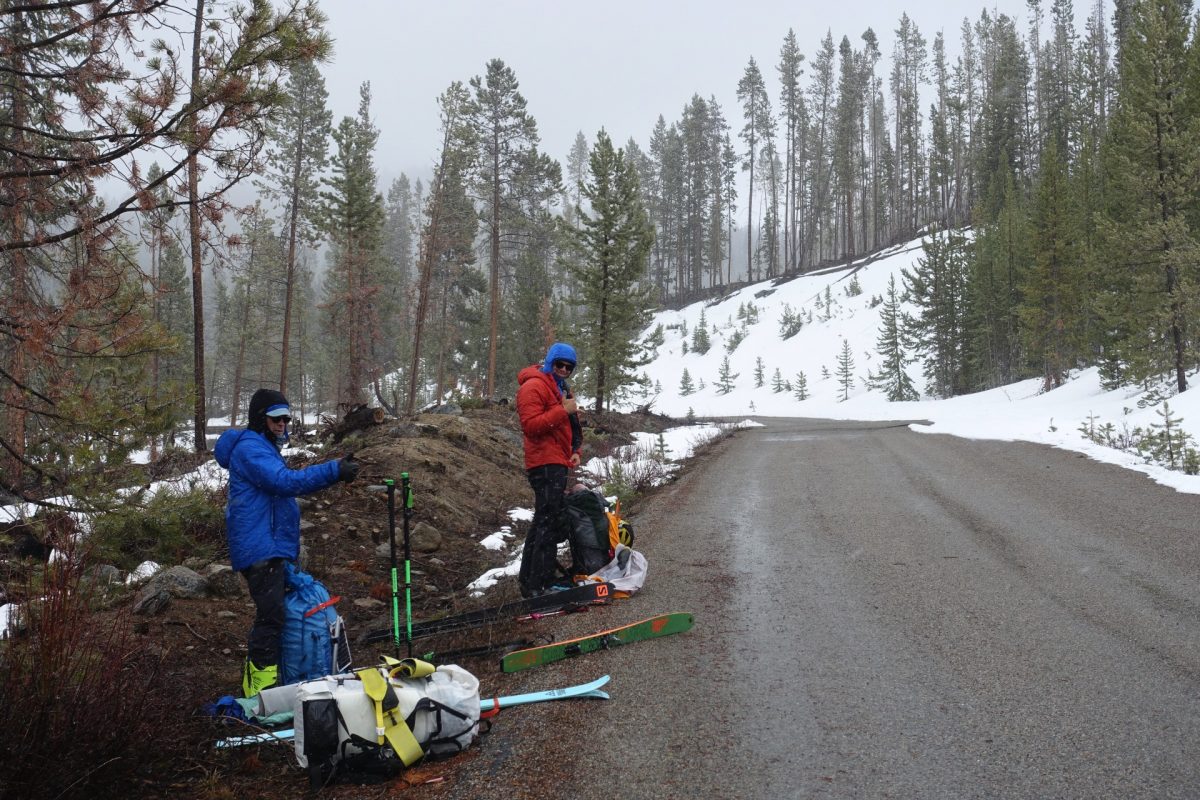
Thumbs out in a light drizzle awaiting a ride to Pinedale, WY. The Vapor Carbon 2’s electric green color is a win-win when skiing in flat light, and flagging down a ride.
Conclusions
Let’s talk about that sweetness. I went from religiously using the Vapor Carbon 2 and pivoted to the MTN S3. That’s like going from an 80mm underfoot ski to something girthier, like a 105mm. There’s some more oomph to it.
That’s how it is with the MTN S3; more heft. I can see why Mr. Townsend has been yarding this pole to and fro on his Fifty quest. Although they are an all-carbon shaft, they are sturdy, well-crafted, and honestly seem as durable as the assortment of all-aluminum BD poles I’ve used for nearly 20 years. Those BD all-aluminum poles have served me well, and they often are for sale at a reasonable price point, but I have come to believe that the extended grip is more comfortable and efficient for me while touring. (I’m someone, for example, with two different height-adjusted poles on zig-zagging skin tracks. After a kick turn, I swap the shorter pole to the uphill hand. There’s no need for that hassle with an extended grip.)
One might see the overbuilt nature of the MTN S3 initially like a flaw in the cost-benefit analysis — the cost is the heft and sturdiness — but it is, in fact, an asset. I’m not sure how much heavier an all-aluminum version of the MTN S3 would be, so maybe it makes sense to construct it from carbon. But poles can be fragile, especially carbon ones. The MTN S3s are not flimsy poles, making them an excellent option for someone looking for a full-featured two-section telescoping pole with an extended grip (and removable/breakaway straps too). If you are pushing into big-mountain-themed skiing or want a hearty multifunction ski pole, the MTN S3 delivers. If you are a weight weeny, steer clear. Bashers and bangers, and even those keen on the light and fast, might like the psychic comfort of knowing the MTN S3 handles a beating.
Weight weenies, which I can be on occasion, can drool over the Vapor Carbon 2 and Duos Freebird if they seek an adjustable length elongated grip pole. I’m hesitant to side either way, but I like the semi-molded hand grip on the Vapor Carbon 2, which is absent on the Duos Freebird. And if aesthetics matter to you, these two poles are lookers; there’s the BD-themed fluoro green on the Vapor Carbon 2, and the polished flat enamel over carbon weave look of the Duos Freebird. The MTN S3, which I noted is the tank of the lot here, and fittingly, the lower shaft is a military drab green.
The adjustable poles reviewed here come in on the semi-short side if you do a lot of skating on your backcountry setup to access zones. At 140cm, the Duos Freebird slots in 5cm longer than the other two poles, but 140cm is at the low end of what I like when extending a pole for skating. Even 135cm, the max length of the Vapor Carbon 2 and MTN S3, is doable, but at my height, I get some lower back soreness when skating with this length pole.
The bottom line, these three options are a great place to start if you are in the market for a telescoping extended-grip pole.
List Prices:
Salomon MTN Carbon S3 — $199.95
Black Diamond Vapor Carbon 2 — $199.95
Black Crows Duos Freebird — $164.95
Jason Albert comes to WildSnow from Bend, Oregon. After growing up on the East Coast, he migrated from Montana to Colorado and settled in Oregon. Simple pleasures are quiet and long days touring. His gray hair might stem from his first Grand Traverse in 2000 when rented leather boots and 210cm skis were not the speed weapons he had hoped for. Jason survived the transition from free-heel kool-aid drinker to faster and lighter (think AT), and safer, are better.





